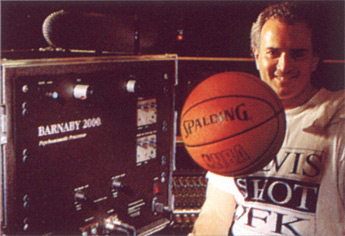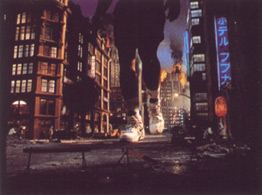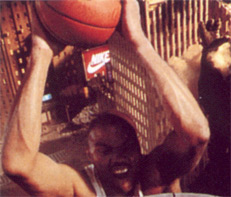

Godzilla vs. Barkley in 3-D Sound
Not often do 30-second commercial television spots have the production and marketing budgets of a small-scale feature film, complete with teasers announcing it as a coming attraction. But then it's not often that Godzilla meets basketball superstar Charles Barkley on the streets of Tokyo.

|
Jeff Roth, Focused Audio, in front of the Barnaby 2000 Imaging System |
Nike's new shoe campaign debuted on the MTV Music Awards broadcast on September 9. Before that, however, there were posters, T-shirts, full-page ads in Rolling Stone, teasers–everything short of a McDonald's soft drink cup. No expenses were spared in production, from the stunning visuals produced by Industrial Light & Magic, to the big bucks for Charles Barkley, to the rights for Godzilla. (Yes, somebody owns the rights to Godzilla.) By the time the spot hit audio post at San Francisco's Focused Audio, there was considerable, albeit unspoken, pressure to deliver a soundtrack as big as the 150-foot main characters.
"The imagery is really like a 30-second movie," says Focused Audio owner Jeff Roth, "and you can't let that kind of image go by without the sound treatment of a feature film. The layers have to be there. Every sound you take, whether it's explosions or screams or footsteps, needs to be pitched because these guys are 150 feet tall. Even if you Foley a footstep with some gravel under it, it'll sound ludicrous to picture without the shifts."
All the pitch-shifting was accomplished in Pro Tools ("You can do really large shifts with no anomalies," says Roth), with editing mainly taking place on the 16-track AMS AudioFile Plus. The mix went through a 40-channel Sony/MCI JH-636 with DiskMix II+ automation, which came in handy when recalling for a PAL version and a mono film mix. The monitors in Focused are JBL 4435s.

|
So what kinds of sounds are we talking about? Fire, steam, explosions, building demolition, Godzilla growls, Barkley growls, fires, low rumbles, screams. All of the ambient effects and music–basically anything that wasn't a hard effect and didn't require frame accuracy–were placed on the Sony JH-24 24-track machine with Dolby SR. As Roth says, it's a long shot that the client will want to move the fire sound by one frame.
The voices, explosions and basketball, however, were placed in the AudioFile for accurate lock-to-picture. Godzilla's voice comes from four different sources. Some was pulled directly from the laserdisc of a 1985 remake. Some came from the Hanna-Barbera library, which Roth believes is what they used on the original 1956 film (an elephant trumpet, followed by an elephant roar, pitched down several octaves). Some came from lion growls off a new Network library ("a friendlier, more talkative type of voice," used near the end of the spot). And some came from mix engineer Jay Shilliday growling into a mic. Barkley's voice was delivered on 1/4-inch.
But the basketball sound is what grabs you, first appearing from off-camera, stage right. It's a big ball, and the sound had to stand out, which is why Roth and company recorded binaurally with the custom Barnaby 2000 Sonic Imaging System, developed by Jeff Gold.
"One of the reasons we chose to do the ball in 3-D," Roth explains, "is that I like to work in stereo on everything, and that builds up lots of layers of tracks. On this spot we had 40 tracks going, but typically in the mix you have all these elements fighting with each other and you end up playing with equalization. What Jeff Gold has done with Barnaby 2000 is develop an EQ that helps the spatial information be mono-compatible so that nothing disappears when it folds into mono. The EQ adds no equipment-induced phasing, and it highlights the directional information–up/down, left/right, front/back–so that you get a 3-D experience through speakers.
"When you have 40 elements happening and you have one that's very important and it's been recorded in the 3-D process, it stands out without monkeying with the board EQ, or adding effects, or trying to add more level," Roth continues. "It stands out from the other elements spatially."

|
The basketball's importance goes beyond the mere bounce sounds. It is tied to the rhythm of the music tracks. In fact, three music mixes were delivered on DAT for the final, composed by Big Trax's Dan Obst with a 76-piece orchestra on the MGM lot in Hollywood. The first mix was basketball only; the second was full music with basketball; and the third was full music minus basketball, which is what was eventually used.
Roth and Gold then recorded their own basketball sounds, bouncing a ball in seven incremental steps toward Barnaby 2000–Gold's mannequin "Barnaby" with two microphones placed in its ears to simulate human psychoacoustic recognition. There are really two sounds involved: the bounce as it hits the floor, and the "ping" as it rises in the air. It's the ping that provides the most directional information, as it has much higher frequency information. Then, in the same seven incremental locations, Roth slapped the ball to provide the hand-meets-ball sound. Essentially, Barnaby 2000 serves as a stereo mic, with left and right signals stored on separate channels of the DAT.
Everything then went into the AudioFile, with the absolute time from the DAT providing enough accuracy to establish sync. Shilliday added in a few explosions to augment the bounces, and presto! 3-D from your TV. Final mix was to DAT at 48 kHz, laid back to a D-1 master. Actually, Widen and Kennedy producer John Adams called for two video edits, resulting in two D-1 masters–one for NTSC, one for PAL. The AudioFile's time expansion capabilities were used to quickly adjust the length of the spot 4% for the PAL DAT. The film mix followed a few weeks later for distribution in Europe and Asia.
Mix Magazine, November 1992